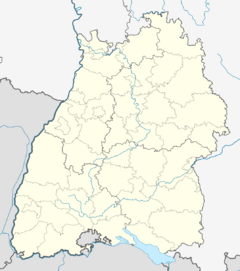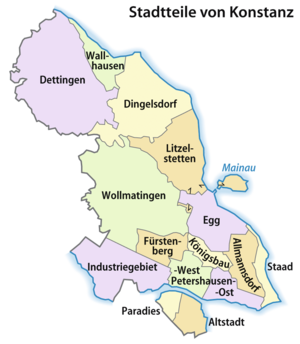Konstanz facts for kids
Quick facts for kids
Constance
Konstanz
|
|||
|---|---|---|---|

Rheintorturm, a section of the former city wall of Konstanz at Lake Constance
|
|||
|
|||
|
Location of Constance within Konstanz district
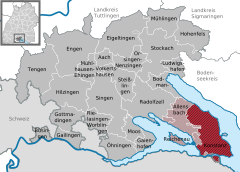 |
|||
| Country | Germany | ||
| State | Baden-Württemberg | ||
| Admin. region | Freiburg | ||
| District | Konstanz | ||
| Subdivisions | 15 | ||
| Area | |||
| • Total | 55.65 km2 (21.49 sq mi) | ||
| Elevation | 405 m (1,329 ft) | ||
| Population
(2022-12-31)
|
|||
| • Total | 85,859 | ||
| • Density | 1,542.84/km2 (3,995.9/sq mi) | ||
| Time zone | UTC+01:00 (CET) | ||
| • Summer (DST) | UTC+02:00 (CEST) | ||
| Postal codes |
78462–78467
|
||
| Dialling codes | 07531, 07533 | ||
| Vehicle registration | KN | ||
| Website | www.konstanz.de | ||
Konstanz (also known as Constance in English) is a lively university city in southern Germany. It has about 83,000 people living there. The city is located at the western end of Lake Constance, which is called Bodensee in German. Konstanz is home to the University of Konstanz and was an important religious center for over 1,200 years.
Contents
Where is Konstanz Located?
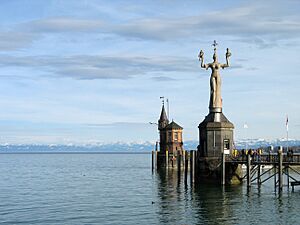
Konstanz is in the state of Baden-Württemberg, right on the shores of Lake Constance. The Rhine river, which starts in the Swiss Alps, flows through Lake Constance. It then leaves the lake, much wider, by going under a bridge that connects the two parts of the city.
The larger part of Konstanz, with homes, businesses, and the university, is north of the river. South of the river is the old town. This area has the city's main offices and many shops. It also has the Hochschule, which is a university for applied sciences.
You can take car ferries across Lake Constance to Meersburg. There's also a special Katamaran boat that takes people to Friedrichshafen. The border between Germany and Switzerland runs along the city's edge, right next to the Swiss town of Kreuzlingen.
City Parts and Areas
Konstanz is divided into 15 different areas or districts, called Stadtteile. One of these areas includes the beautiful island of Mainau. Mainau used to be its own town until it became part of Konstanz in 1971.
A Look at Konstanz's History
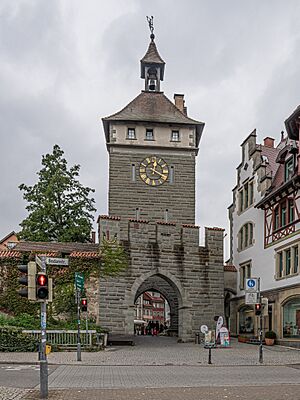
The first signs of people living in Konstanz go back to the very old Stone Age. Later, around 40 AD, the Romans settled here. This small Roman town was likely called Drusomagus at first. Its later name, Constantia, might come from the Roman emperor Constantius Chlorus. He built a strong fort here around 300 AD.
Around 585 AD, the first bishop came to live in Konstanz. This made the city a very important religious place. By the end of the Middle Ages, about a quarter of Konstanz's 6,000 people were church workers. This meant they didn't have to pay taxes.
Trade was very successful during the Middle Ages. Konstanz had the only bridge over the Rhine in the area. This made it a key location for trade. The city was also famous for its linen cloth, which brought it a lot of wealth. In 1192, Konstanz became an Imperial City. This meant it was only answerable to the Holy Roman Emperor, not to local dukes.
The Council of Constance
A very important event, the Council of Constance, happened here from 1414 to 1418. During this council, a religious reformer named Jan Hus was sadly burned at the stake in 1415. The council also helped to end a big split in the Roman Catholic Church. A new Pope, Pope Martin V, was chosen here. This was the only time a Pope was elected north of the Alps!
You can still see the Konzilgebäude (Council Building) by the harbor where the Pope was chosen. Nearby is the Imperia statue. It was put up in 1993 to remember the council in a funny way.
Changes and Challenges
In 1460, the Swiss Confederacy took over Thurgau, an area close to Konstanz. Konstanz tried to join the Swiss Confederacy, but they said no. So, Konstanz joined the Swabian League instead. In a war in 1499, Konstanz lost its last special rights over Thurgau to the Swiss.
In the 1520s, the Protestant Reformation came to Konstanz. The city officially became Protestant. Church pictures were removed, and the bishop moved away for a while. However, in 1548, Emperor Charles V ordered Konstanz to surrender. The city had to give up its special status and became part of Habsburg Austria.
The new Habsburg rulers wanted to bring back the Catholic faith. In 1604, a Jesuit College was opened. Its theater, built in 1610, is the oldest theater in Germany that still puts on shows regularly.
Konstanz became part of the Grand Duchy of Baden in 1806. In 1821, the Bishopric of Constance was closed. Konstanz then became part of the German Empire in 1871. After World War I, it was part of the Republic of Baden.
During World War II, Konstanz was not bombed by the Allied Forces. This was because it is very close to the Swiss border. After the war, Konstanz became part of the new state of Baden-Württemberg.
The Altstadt (Old Town) of Konstanz is quite large and has many old buildings and winding streets. The city's skyline is known for the Konstanz Cathedral. There are also other churches and three towers left from the old city wall. One of these towers marks where the medieval bridge over the Rhine used to be.
The University of Konstanz was built near the city in 1966. It has a huge library with about two million books. These books are available 24 hours a day. The university also has a botanical garden. Since 2007, the university has become very well-known as an "elite university" in Germany.
Konstanz is also the birthplace of Count Ferdinand von Zeppelin. He was the inventor of the famous Zeppelin airships.
In recent years, Konstanz has become a popular place for people from Switzerland to shop. This is because prices for basic items are lower in Germany. Also, the exchange rate between the Swiss franc and the euro is good for Swiss shoppers. Many Swiss visitors also get a refund on the German sales tax. This has led to new, large stores being built near the city center. Some people in Konstanz feel the city is losing its historic feel because of this.
Climate in Konstanz
Konstanz is in southwest Germany. It has a mild oceanic climate. This means it has warm, humid summers, but the lake helps to keep them from getting too hot. Winters are cold and can have snow.
Places to Visit in Konstanz
- Archaeological Museum
- Imperia, a 9-meter-tall statue
- Jan Hus Museum
- Konstanz Cathedral
- Konzil building, from the 15th century
- Niederburg (Lower Castle)
- Petershausen Abbey
- Remains of a Roman fortress, near the Cathedral
- Schnetztor, a strong gate from the old city walls
Konstanz also used to have a large synagogue. Sadly, it was destroyed by the Nazi government in 1938.
Sister Cities
Konstanz has special friendships with other cities around the world. These are called twin towns or sister cities:
- Fontainebleau, France (since 1960)
- Richmond upon Thames, England, United Kingdom (since 1983)
- Tábor, Czech Republic (since 1984)
- Lodi, Italy (since 1986)
- Suzhou, China (since 2007)
Getting Around Konstanz
Konstanz station is a main train station. It's the end point for the High Rhine Railway line. This line goes west to Singen, connecting to other parts of Germany and Swiss cities like Schaffhausen and Basel. There are three other train stations in Konstanz: Konstanz-Fürstenberg, Konstanz-Petershausen, and Konstanz-Wollmatingen.
Konstanz station is also linked to the Lake Line, which runs along the Swiss side of Lake Constance. Train services are provided by Deutsche Bahn AG (German trains) and also by Swiss Federal Railways and its companies.
The closest airport is in Friedrichshafen. You can get there by a fast ferry boat across the lake. This ferry also connects Konstanz to other towns on the lake. Friedrichshafen airport mostly has flights within Germany, but also to Austria and Turkey. For international flights, the closest big airports are in Stuttgart, Basel, and Zurich. Zurich has a direct train from Konstanz. Buses help people get around inside Konstanz.
Since 2005, Konstanz and Friedrichshafen have also been connected by catamaran boats named Constance and Fridolin.
World Heritage Site
Konstanz is home to some very old pile-dwelling settlements. These are houses built on stilts over water. They are part of the Prehistoric Pile dwellings around the Alps UNESCO World Heritage Site. This means they are very important historical sites recognized by UNESCO.
Famous People from Konstanz
- Ulrich Zasius (1461–1536), a legal expert.
- Ernst Vögelin (1529–1589), an early book printer.
- Johann Friedrich Cotta (1764–1832), a publisher and politician. He started steamboats on Lake Constance in 1825.
- Johann Leonhard Hug (1765–1846), a Catholic religious scholar.
- Guillaume Henri Dufour (1787–1875), a Swiss military officer and engineer.
- Count Ferdinand von Zeppelin (1838–1917), the inventor of the famous Zeppelin airships.
- Josef Albert Amann (junior) (1866–1919), a doctor specializing in women's health.
- Conrad Grober (1872–1948), a priest and archbishop.
- Werner Maihofer (1918–2009), a politician who was a minister in Germany.
- Theo Sommer (1930–2022), a well-known newspaper editor.
- Rolf Böhme (1934–2019), a politician and mayor of Freiburg.
- Ian Murdock (1973–2015), an American software engineer who started the Debian project.
- Larissa Vassilian (born 1976), a German-Armenian journalist.
- Marie Ellenrieder (1791–1863), a painter.
- Ida Maier-Müller (1821–1904), a landscape painter.
- François Stahly (1911–2006), a French sculptor.
- Martin Gotthard Schneider (1930–2017), a church musician and songwriter.
- Uli Trepte (1941–2009), a musician.
- Carola Zwick (born 1966), a product designer.
Images for kids
See also
 In Spanish: Constanza (Alemania) para niños
In Spanish: Constanza (Alemania) para niños





